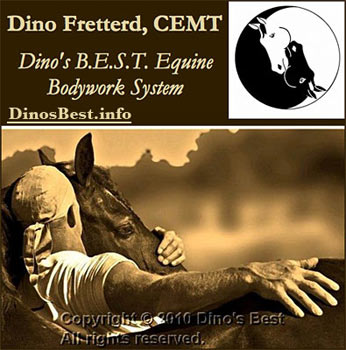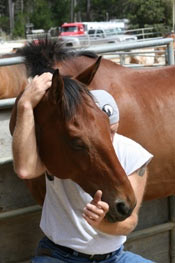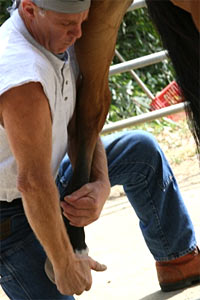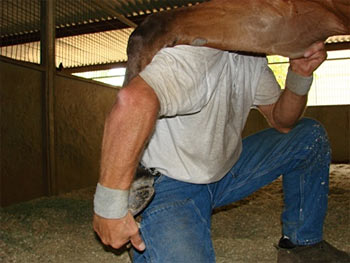|
Horse Posture and Performance
 |
As a professional bodywork therapist for over 30 years and practicing in the equine field solely for the last 15
years I have learned some amazing information and put it together in a format that is easy to understand and just makes sense.
From Dino Fretterd CEMT
Posture or stance of a horse is easily understood if you can understand how three concepts or laws of the universe operate. The three concepts are balance, function and gravity.
Balance: The truest definition of balance when applied to a physical object is point of equilibrium. Meaning there is no greater
stress to any physical object in any direction.
Function: An action or use for which something is designed.
Gravity: The natural force drawing a physical object toward the earth.
If you apply these three concepts to three components of the horse which include:
 The Tempromandibular joint (TMJ) the jaw of the horse; The Musculoskeletal structure comprised
of muscles, tendons, ligaments and bones; The Foundation or the horse’s feet (hoofs) You can begin to understand posture. The Tempromandibular joint (TMJ) the jaw of the horse; The Musculoskeletal structure comprised
of muscles, tendons, ligaments and bones; The Foundation or the horse’s feet (hoofs) You can begin to understand posture.
The function of the TMJ is to open and close the mouth, allow for bilateral excursion or side to side as well as anterior/poster or forward and backward movements.
The function of the muscles are to create movement when a contraction occurs thus pulling on the skeletal structure creating an extension (away from the body) or flexion (toward the body) motion.
The function of the hoof is to create a foundation, creates direction of flight of appendage, and dissipates concussive forces as well as acting as a pump to move blood and lymphatic fluid back
up the appendage.
Now that it is clear as to function of the components we can discuss in more detail how we put this package together.
 Every muscle has an action as well as having an opposite reaction. Every time you contract a muscle, its opposite must elongate or stretch to allow the contraction to happen. Muscles
work in a three phase cycle being excitation/ contraction/ relaxation. Muscles contract to create motion, but may also stay in a mild contracted state to support an imbalance. Think
about holding a piece of paper in your fingers. You are in an excited and contracted state as long as you hold that piece of paper. This is a mild contraction because it takes very little effort
to hold it, but as long as you are holding that paper one set of muscles stay contracted while their opposites stay elongated. Every muscle has an action as well as having an opposite reaction. Every time you contract a muscle, its opposite must elongate or stretch to allow the contraction to happen. Muscles
work in a three phase cycle being excitation/ contraction/ relaxation. Muscles contract to create motion, but may also stay in a mild contracted state to support an imbalance. Think
about holding a piece of paper in your fingers. You are in an excited and contracted state as long as you hold that piece of paper. This is a mild contraction because it takes very little effort
to hold it, but as long as you are holding that paper one set of muscles stay contracted while their opposites stay elongated.
Think of a horse with low heels. This simply means the horse has some type of contraction of the extensor muscles. Better yet, think of what it takes to ride a motorcycle. You have to pull
backward on the throttle to move, or contract your extensor muscles. How about a horse that is more upright or even over at the knee (carpus) which is really their wrist. You can flex your
wrist by contracting the flexor muscles of your forearm. If you stay in that contracted position and were a horse…….you would be over at the knee.
Now if we look at the hoof as nothing more than a fingernail we can learn to assess weight load distribution. Press on your fingernail on either side and watch it turn white were the pressure is. You have forced the blood flow to its opposite side. Lack of
blood means lack of growth (which will be discussed in more detail in an upcoming article).
Let’s not forget what I call the most important joint in the body…….the tempromandibular or jaw. As to not get into great detail
about teeth in this article, but imperative to understand, the teeth set the occlusive pattern and create the guidance system for
which the tmj operates. If a horse is in an occlusive pattern disallowing anterior movement of the jaw, they will hold a higher head
set. Everyone knows where the head goes… the body follows. A higher head set creates an imbalance in the weight distribution.
It is written in every anatomy book I have read that approximately sixty percent of a horses weight is bore by the front feet. The
higher the head set, the lower the heel. Tilt you head backward just a little and you will see you forced more pressure to your
heels. Lean forward and you will grab with your toes so you don’t fall forward. Either case you have contracted muscles to support yourself.
So if you have one set of muscles that  are passively contracted, you have an opposite group that is always elongated. If you add
dynamic motion into the equation you can see how much harder the elongated group has to work to pull the contracted side. It’s like a tug of war with the muscles creating tension on joints. Tension on
joints creates posture. Posture can be changed by stretching and training muscles to be balanced. If someone is slouching and you tell
them to stand up straight, and they do, they have just changed their posture right before your very eyes. As long as they contract those muscles, they stay in that proper posture. The same is true for horses
. Poor posture leads to poor performance and injury. are passively contracted, you have an opposite group that is always elongated. If you add
dynamic motion into the equation you can see how much harder the elongated group has to work to pull the contracted side. It’s like a tug of war with the muscles creating tension on joints. Tension on
joints creates posture. Posture can be changed by stretching and training muscles to be balanced. If someone is slouching and you tell
them to stand up straight, and they do, they have just changed their posture right before your very eyes. As long as they contract those muscles, they stay in that proper posture. The same is true for horses
. Poor posture leads to poor performance and injury.
By learning how to assess these components you can understand how to best help your horse. Balanced stretching and strengthening
techniques , as well as assessing movement and position of the tmj is something virtually anyone can learn to do.
This is an overview for better understanding of your horse’s posture and performance. I will cover a more detailed co-relation of
the TMJ and dental occlusion and the Structure (body) as well as the co-relation of Structure and Foundation (hoof) in future articles.
My passion now is to help educate and share the knowledge of which I have acquired as to help the world of horses.
|